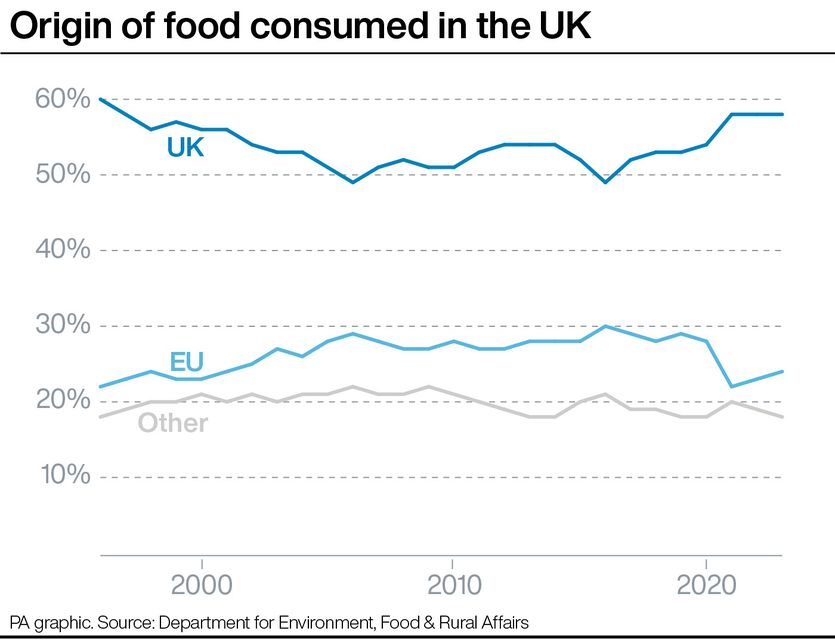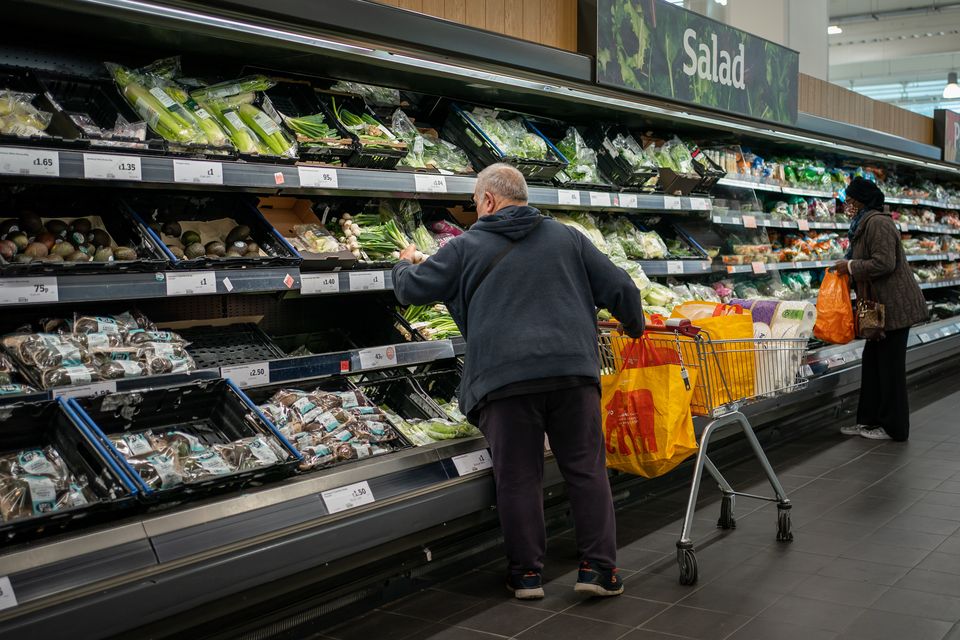Here are some of the key statistics in the 2024 UK Food Security Report, which has been published by the Department for Environment, Food & Rural Affairs (Defra).
– Food sources
The UK in 2023 sourced 58% of its food from domestic production, 24% from the European Union and 18% from other countries: 7% from America, 4% from Africa, 4% from Asia/Australia and 3% from the rest of Europe.
The proportion of food from domestic production has risen in recent years, having been down at 49% in 2016.
But it is still below the levels seen in the late 1980s and early 1990s, including a peak of 67% in 1989.
(PA Graphics)
– Self-sufficiency
For foods that can be grown in the UK, the production-to-supply ratio in 2023 stood at 75%.
In other words, around three-quarters of those foods consumed in this country that could also be produced in the UK (indigenous food) were actually homegrown.
This figure, which is used as a measure of the UK’s self-sufficiency, has been broadly stable for the past two decades, and is up slightly from 74% in 2021.
It stood at 95% in 1984.
For all foods consumed in the UK in 2023, 62% were homegrown, up slightly from 61% in 2021 but well below the modern-day peak of 78% in 1984.
– Imports
The European Union continues to be the main source of food and drink imports for the UK, although the proportion has changed in recent years.
The figure of 24% in 2023 is up from 22% in 2021 and 23% in 2022, but is below the levels seen before the UK left the EU, which were nearer to 30% in the mid-2010s.
The fall in imports from the EU has been offset partly by an increase in domestically produced food and drink.
– Homegrown foods
Among indigenous foods, 93% of all cereals consumed in the UK last year were produced here, as well as 87% of eggs, 85% of beef, 82% of poultry and 64% of pork, while the UK produced more milk than it consumed.
Some 62% of all foods consumed in the UK in 2023 were homegrown (Aaron Chown/PA)
The figures are sharply lower for fresh vegetables (53%) and fresh fruit (16%).
This is “due to UK climate suitability, seasonality and consumer and producer choices”, according to Defra.
– Fruit and vegetables
While some 16% of fresh fruit consumed in the UK in 2023 was produced in this country, the figure is double the level two decades earlier in 2003, when it stood at 8%.
By contrast, the proportion of fresh vegetables consumed in the UK that are homegrown has fallen, from 63% in 2003 to 53% in 2023.
Among fruits indigenous to the UK, 66% of strawberries consumed in the country last year were homegrown, along with 38% of raspberries and apples but some 13% of pears and plums.
Among indigenous vegetables, while 96% of carrots, turnips and swedes consumed in the UK in 2023 were also grown here, the figure drops to 81% for cabbages, then to 49% for cauliflower and broccoli, 48% for mushrooms, 44% of lettuce and 15% of tomatoes.
– Vegetable production
Between 2021 and 2023, the volume of domestic production of vegetables decreased by 13% to 2.2 million tonnes, a period that also saw the price of vegetables increase.
The drop in production was mainly caused by extreme weather conditions, when “a wet spring affected planting and harvesting, significantly delaying the start of the season for most crops”, according to Defra.
“In early summer, the weather turned hot and dry, so that any crops established in this period favoured farmers with access to irrigation and those without struggled to get crops to germinate or grow.
“In July, the weather turned wet, and this persisted until the end of the year, causing harvesting and disease issues.”
A fall in the volume of domestic production of vegetables between 2021 and 2023 was mainly caused by extreme weather conditions (Joe Giddens/PA)
– Fruit production
While the volume of fruit production in the UK was higher in 2023 than 2021, this masks a drop year-on-year between 2022 and 2023 by 12%, from 663 thousand tonnes to 585 thousand, which – as with vegetables – was a result of extreme weather conditions.
Production of culinary apples in 2023 stood at 59 thousand tonnes, the lowest for the past 10 years, thanks to reductions in both the planted area (down 1.2%) and yields.
“Trees that had suffered from drought stress in 2022 had significantly less blossom in 2023,” Defra noted.
“Cold winds during flowering in May adversely affected pollination and reduced crop potential.”


